Chilcott St, Lambton
There’s often a story lurking behind street names. While many of our streets owe their existence to the rise of mines, some have their origin in the demise of mines. The Scottish Australian Mining Company opened Lambton colliery in 1863. Adjacent to the pit they established a small township bounded by Young, Morehead, Croudace and Howe Streets, these being named after managers and directors of the company.
For the next 50 years the company made their fortune underground, but when the coal seam was depleted, they looked instead to make money above ground, in real estate. They began in August 1914 with a modest subdivision of 24 blocks on the south side of Howe St. On 17 January 1920, one hundred years ago this month, the company auctioned a bigger subdivision with 61 building sites. As was the custom at the time the sale was publicised using large coloured poster prints.
The subdivision included two newly constructed streets. Turner St was named after Frederick William Turner, the London based secretary of the Scottish Australian Mining Company. Chilcott St was named after Henry Frederick Chilcott, the Sydney based General Manager.
Chilcott was born in Ceylon (now Sri Lanka) in 1844 and was brought by his family to Australia when he was three. At age 14 he joined the Scottish Australian Mining Company in a junior capacity, and was progressively promoted, eventually becoming General Manager in 1892. Chilcott was also a long-time member of the Colonial Volunteer Forces, a forerunner of today’s Army Reserve, enlisting in 1860 and rising to the rank of Captain by the time of his retirement in 1894.
In a strange coincidence, Henry Chilcott died on 21 January 1920, just four days after the auction of land in the street named in his honour. He was aged 76, still holding the position of General Manager in the company that he had served for an impressive 62 years.
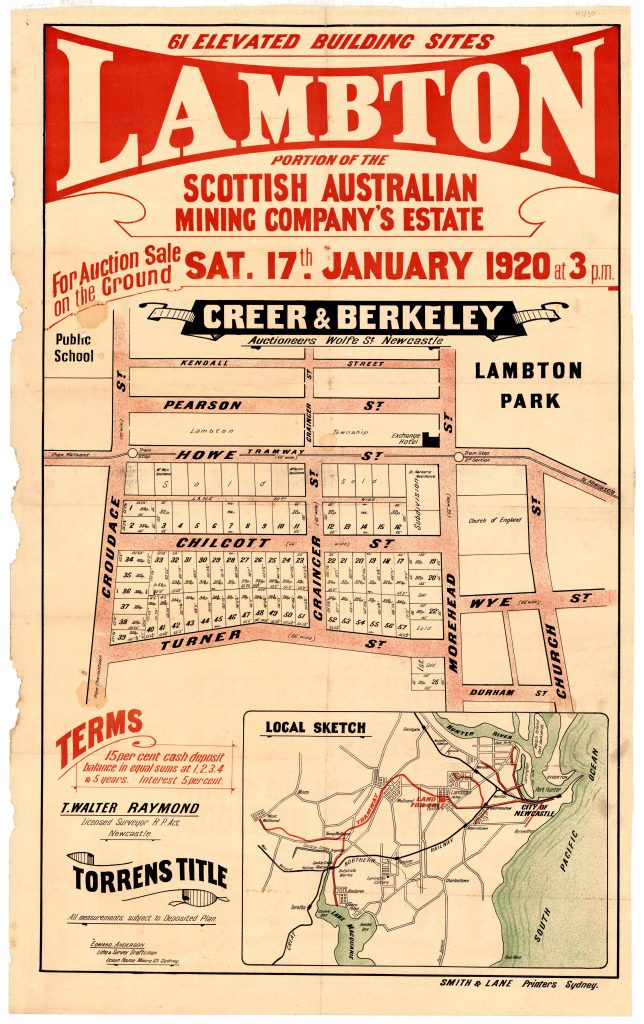
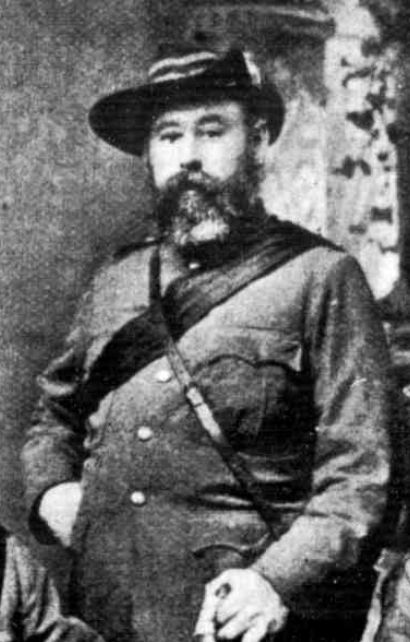
The article above was first published in the January 2020 edition of The Local.
Acknowledgements
My thanks this month go to Greg Manning, whose research into Chilcott St alerted me to Henry Chilcott’s birthplace being in Ceylon, and led me to the photograph of Chilcott in his military uniform.
Additional Information
EmPloyment Start
There is some slight ambiguity as to the exact year that Chilcott joined the Scottish Australian Company. An article from 1894 states that Chilcott “was born on January 5, 1844” and that “he has been connected [to the company] since he was 15 years of age. This implies that Chilcott joined the company in 1859. However the article reporting his death in 1920 states that he joined the company in 1858, implying that he was aged 14 at the time.
Lambton Streets
The streets in the the early Lambton township were mainly named after managers and directors of the Scottish Australian Mining and Investment Companies, owners of the Lambton colliery.
| Street | Notes |
| Young St | Named after Matthew Young or Adolphus William Young MP, or possibly both. Matthew Young along with Robert Morehead was an early manager of the Scottish Australian Mining Company in Sydney. The mineral leases of the Lambton colliery were original held by “Morehead and Young”, and then subsequently taken over by the S.A.M. Co soon after the company’s registration. Adolphus William Young was a director of the Scottish Australian Investment Company in England. |
| Croudace St | Named after Thomas Croudace (b. 1838, d. 15 Jun 1906), manager of Lambton Colliery and subsequently General Manager of the Scottish Australian Mining Company in Australia. |
| Grainger St | Named after Charles Garston Grainger, director and secretary in London of the Scottish Australian Investment and Scottish Australian Mining Companies. Resigned 1885. |
| Morehead St | Named after Robert Archibald Alison Morehead (b. 1812? d. 9 Jan 1885), General Manager of the Scottish Australian Mining Company in Australia. |
| Dickson St | Probably named after William Henry Dickson, one of the proprietors of the Scottish Australian Investment Company. |
| De Vitre St | Named after James Denis De Vitre, director of the Scottish Australian Mining Company. Retired February 1872. |
| Elder St | Named after Alexander Lang Elder (d. 5 Sep 1885), director of the Scottish Australian Investment and Scottish Australian Mining Companies. Although Elder died in September 1885, he continued to be listed as a director of the company in Australian newspapers until 13 Mar 1886. An updated list of directors appeared on 20 Mar 1886. |
| Kendall St | Named after Charles Holland Kendall, a director of the Scottish Australian Investment Company. |
| Pearson St | Named after Sir Edwin Pearson (d. 1883), director of the Scottish Australian Investment Company. |
| Howe St | The original spelling was “How” St”. The street is almost certainly named after Robert How, an investor in the Scottish Australian Mining Company. |
| Chilcott St | Named after Henry Frederick Chilcott (b. 5 Jan 1844, d. 21 Jan 1920), General Manager in Australia of the Scottish Australian Investment and Scottish Australian Mining Companies. |
| Turner St | Named after Frederick William Turner (d. September 1928) director of the Scottish Australian Investment Company, and secretary of the company in London. |
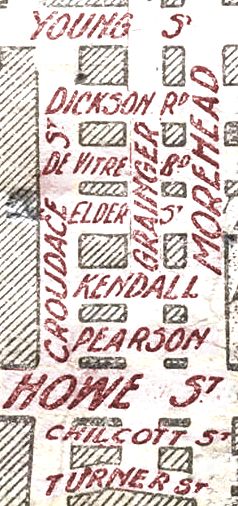
Howe Street
The original plan of the Lambton township from 1864 shows the road on the southern boundary road as “How Street”,
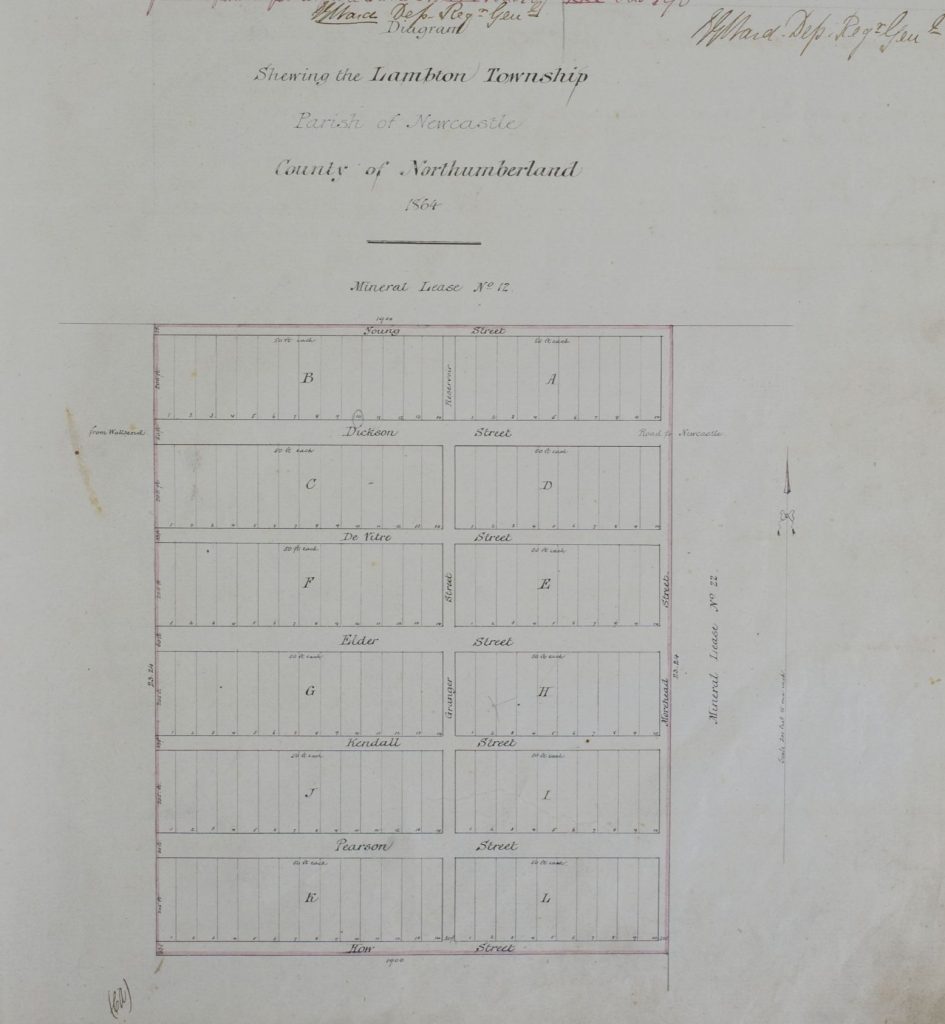
The street is almost certainly named after Robert How, who in 1864 was a director of the Cadiangallong copper mine near Orange. This mine was worked by the Scottish Australian Mining Company, and given the overlap of directors between the two companies it is quite likely that How was also a director or investor in the Scottish Australian Mining Company. The Government Gazette of 14 Oct 1873, shows “How-street” in the list of Lambton streets. As early as April 1872, the spelling starts appearing with a trailing “e”.
[Note that the Lambton Primary School centenary booklet in 1965 stated that Howe St was “named either in honour of the Earl of Howe (prominent Englishman of the day) or John Howe a well known explorer and pastoralist in the Hunter Valley.” Both these suggestions are almost certainly wrong, and arise because of not knowing the original spelling of the street name.]
Croudace Street
One curious anomaly in the early Lambton street names is that at one time there were two Croudace Streets. As well as the north-south road we know today, for some period of time the section of road along the south side of Lambton Park (now Howe St) was called Croudace St. See for example the map on a real estate poster from 1906. (For information on the section of LLoyd Rd running across Lambton Park, see my January 2016 article.)

At first I thought this was an error by the map maker, but I found many other maps of the era also had the street labelled as Croudace St. I then found a proclamation in the Government Gazette of 22 Nov 1878 that names the road between Church St and Lambton Coal Company’s railway as being Croudace St – so the map makers were correct in their labels.
In the period 1916 to 1935 the road south of Lambton Park gets referred to as “Howe Street East” and afterwards simply as “Howe Street”.
So why was there two Croudace Streets? It seems that in the 1860s and 1870s street names were still in a bit of flux. When you look at the Government Gazette proclamation of roads there are many names that don’t match what we have today.
- 14 Oct 1873 – mentions a “Reservoir-street”, which the 1864 Lambton Township map shows to be the section of Grainger St north of Dickson St.
- 22 Nov 1878 – mentions a West Street and a Crozier St that do not exist today.
- 27 Aug 1880 – mentions “Swamp-street”
The naming of the road to the south side of Lambton Park as Croudace St was possibly done by some bureaucrat based in Sydney, unaware of the Lambton locality, and unaware that there was already another street known by the locals as Croudace St.
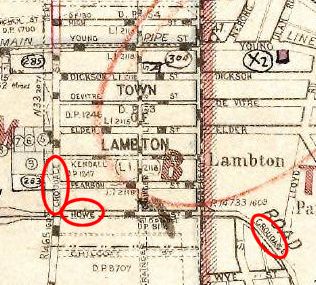
Vol-Fol 486-117 form 1880 shows that Crozier Street was the section of the main road between Lambton and New Lambton that lay to the south of the Lambton Colliery railway.

Today this is Lambton Road.

Newspaper articles
| Article Date Event Date | Notes |
|---|---|
| 25 Nov 1846 21 Nov 1846 | Captain Frederick Biggar Chilcott, his wife, daughter, and infant son Henry Frederick Chilcott arrive in Sydney from Calcutta on the brig Phantom. |
| 15 Jan 1885 1 Jan 1885 | On the retirement of R A A Morehead as General Manager of the Scottish Australian Investment Company, Mr. Archibald Shannon the sub-manager becomes General Manager, and "Mr. Henry F. Chilcott, the accountant, who has been twenty-six years in the service of the company, will succeed to the post to be vacated by Mr. Shannon." |
| 17 Jan 1885 9 Jan 1885 | Death of R A A Morehead, manager of the Scottish Australian Investment Company. |
| 30 Jul 1892 | Archibald Shannon, General Manager of Scottish Australian Investment Company and Scottish Australian Mining Company, returns to England. Thomas Croudace becomes General Manager of the Scottish Australian Mining Company, and although not stated in this article, Henry Chilcott becomes General Manger of the Scottish Australian Investment Company. (See article reporting his death in 1920, that states that Chilcott became General Manager in 1892.) |
| 21 Apr 1894 | Captain Chilcott retires from the Colonial Volunteer Forces. |
| 4 Aug 1894 | Details of The Scottish Australian Investment Company, listing Henry Frederick Chilcott as "Manager in Australia" and Frederick William Turner as "Secretary to the Company in London." |
| 28 Dec 1895 16 Dec 1895 | The "long and meritorious" decoration bestowed on H F Chilcott of the 2nd Infantry Regiment of the Colonial Volunteer Forces, recognising 26 years of service. |
| 14 Jul 1919 | Last mention in Trove of H F Chilcott, General Manager of Scottish Australian Mining, prior to his death. |
| 16 Jan 1920 17 Jan 1920 | "Messrs. Creer and Berkeley will offer at auction to-morrow afternoon 61 elevated building sites at Lambton. These sites form a portion of the Scottish-Australian Mining Company's estate, and are within two minutes of the tram. With bold frontages they face Chilcott, Turner, Croudace and Grainger streets." |
| 23 Jan 1920 21 Jan 1920 | "Mr. Henry Frederick Chilcott, general manager of the Scottish-Australian Investment Company, Ltd., and the Scottish-Australian Mining Company, Ltd. died at his residence, Forest Road, Arnclilffe, on Wednesday. He joined the Investment Company in 1858 in a junior capacity, and in 1892 succeeded to the management upon the death* of the late Mr. Archibald Shannon. In 1904 he succceeded the late Mr. Thomas Croudace in the management of the mining company."
* It was actually on Shannon's return to England, not his death, that Chilcott became general manager. Shannnon died in Torquay in 1898. |
| 22 Jan 1920 | Funeral of H F Chilcott. |
| 6 Sep 1928 | "The death is announced of Mr. Frederick William Turner, a director of the Scottish Australian Investment Company, at the age of 96 years." |

Thank you Lachlan! I am descended from Frederick Biggar Chilcott (Henry Frederick Chilcott’s father) and had wondered if there was a link to my Chilcotts and Chilcott Street Lambton every time I drove past it, but had put that research question on the backburner. Am very pleased to have found your article confirming my hunch!